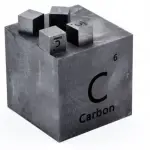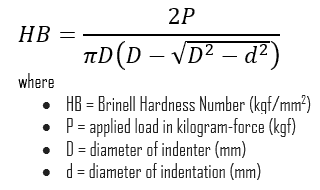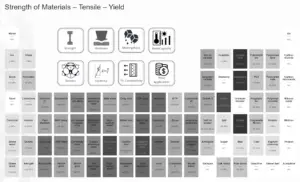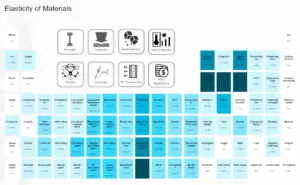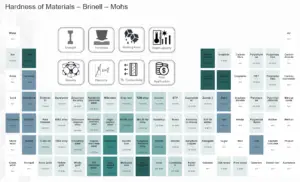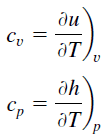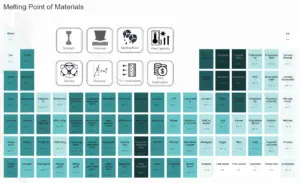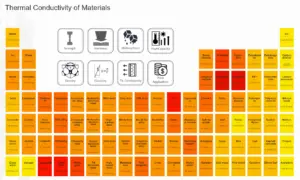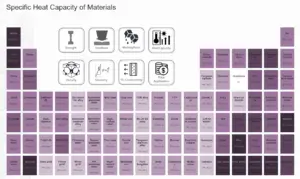About Diamond
Diamond is a form of carbon that is crystallised in a cubic structure with each carbon atom linked by a strong, rigid chemical bond to four other atoms. Diamond is the hardest naturally occurring material known. Yet, due to important structural weaknesses, diamond’s toughness is only fair to good. The precise tensile strength of diamond is unknown, however strength up to 60 GPa has been observed, and theoretically it could be as high as 90–225 GPa depending on the sample volume/size, the perfection of diamond lattice and on its orientation. Diamond has a high refractive index (2.417) and moderate dispersion (0.044) properties that give cut diamonds their brilliance.
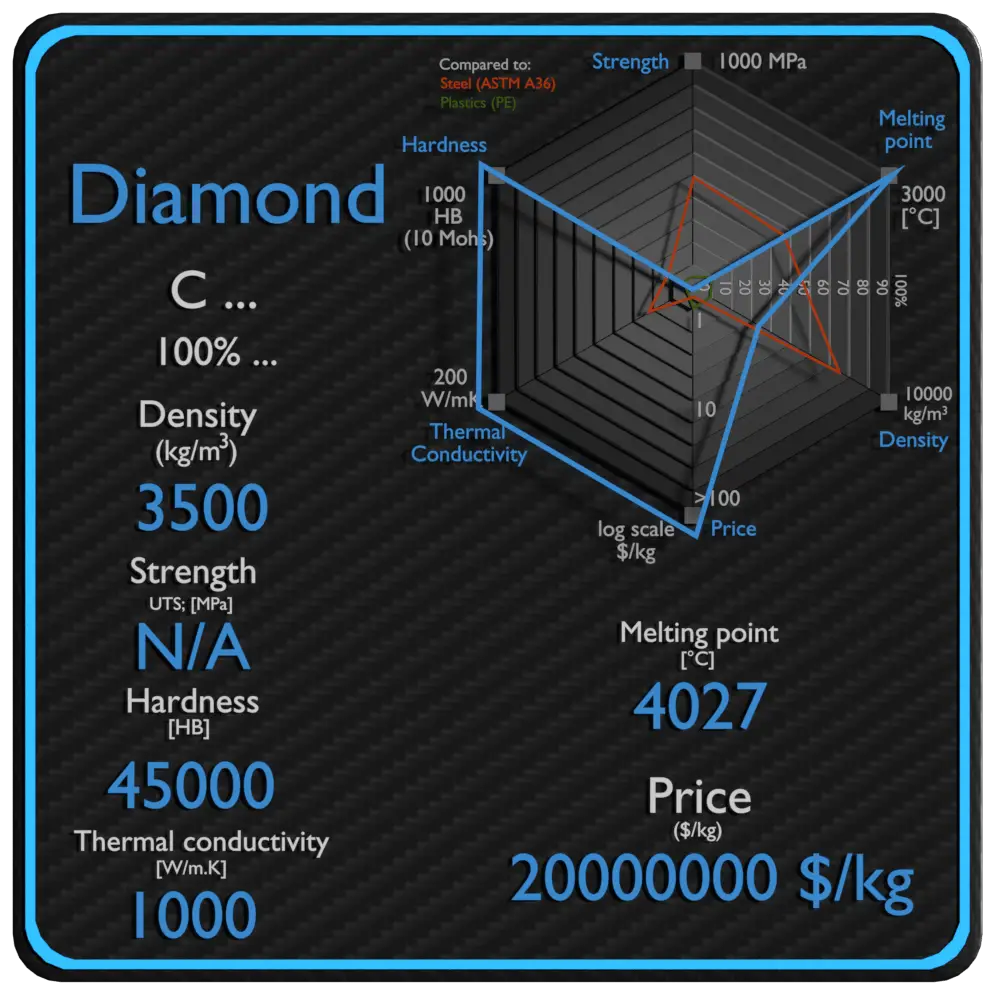
Summary
| Name | Diamond |
| Phase at STP | solid |
| Density | 3500 kg/m3 |
| Ultimate Tensile Strength | N/A |
| Yield Strength | 140000 MPa |
| Young’s Modulus of Elasticity | 1050 GPa |
| Brinell Hardness | 45000 BHN |
| Melting Point | 4027 °C |
| Thermal Conductivity | 1000 W/mK |
| Heat Capacity | 1509 J/g K |
| Price | 20000000 $/kg |
Composition of Diamond
Diamond is the allotrope of carbon in which the carbon atoms are arranged in the specific type of cubic lattice called diamond cubic. Diamond is extremely strong owing to its crystal structure, known as diamond cubic, in which each carbon atom has four neighbors covalently bonded to it.
Applications of Diamond
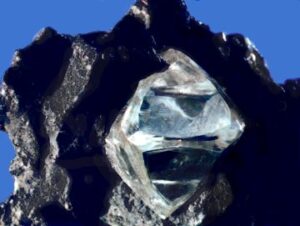
The most familiar uses of diamonds today are as gemstones used for adornment, and as industrial abrasives for cutting hard materials. The markets for gem-grade and industrial-grade diamonds value diamonds differently. In industry, diamonds applications include oil drilling bits, rock drill cutters, wire drawing dies, extrusion dies, cutting tool inserts, optical grinding tools, coatings for computer hard discs and coatings for ball bearings. Diamond is a wide-band gap semiconductor (Egap = 5.47 eV) with high potential as an electronic device material in many devices. Because diamond has such high thermal conductance it is already used in semiconductor manufacture to prevent silicon and other semiconducting materials from overheating.
Mechanical Properties of Diamond
Strength of Diamond
In mechanics of materials, the strength of a material is its ability to withstand an applied load without failure or plastic deformation. Strength of materials basically considers the relationship between the external loads applied to a material and the resulting deformation or change in material dimensions. In designing structures and machines, it is important to consider these factors, in order that the material selected will have adequate strength to resist applied loads or forces and retain its original shape.
Strength of a material is its ability to withstand this applied load without failure or plastic deformation. For tensile stress, the capacity of a material or structure to withstand loads tending to elongate is known as ultimate tensile strength (UTS). Yield strength or yield stress is the material property defined as the stress at which a material begins to deform plastically whereas yield point is the point where nonlinear (elastic + plastic) deformation begins. In case of tensional stress of a uniform bar (stress-strain curve), the Hooke’s law describes behaviour of a bar in the elastic region. The Young’s modulus of elasticity is the elastic modulus for tensile and compressive stress in the linear elasticity regime of a uniaxial deformation and is usually assessed by tensile tests.
See also: Strength of Materials
Ultimate Tensile Strength of Diamond
Ultimate tensile strength of Diamond is N/A.
Yield Strength of Diamond
Yield strength of Diamond is 140000 MPa (Compressive).
Modulus of Elasticity of Diamond
The Young’s modulus of elasticity of Diamond is 1050 GPa.
Hardness of Diamond
In materials science, hardness is the ability to withstand surface indentation (localized plastic deformation) and scratching. Brinell hardness test is one of indentation hardness tests, that has been developed for hardness testing. In Brinell tests, a hard, spherical indenter is forced under a specific load into the surface of the metal to be tested.
The Brinell hardness number (HB) is the load divided by the surface area of the indentation. The diameter of the impression is measured with a microscope with a superimposed scale. The Brinell hardness number is computed from the equation:
Brinell hardness of Diamond is approximately 45000 BHN (converted).
See also: Hardness of Materials
Thermal Properties of Diamond
Diamond – Melting Point
Melting point of Diamond is 4027 °C.
Note that, these points are associated with the standard atmospheric pressure. In general, melting is a phase change of a substance from the solid to the liquid phase. The melting point of a substance is the temperature at which this phase change occurs. The melting point also defines a condition in which the solid and liquid can exist in equilibrium. For various chemical compounds and alloys, it is difficult to define the melting point, since they are usually a mixture of various chemical elements.
Diamond – Thermal Conductivity
Thermal conductivity of Diamond is 1000 W/(m·K).
The heat transfer characteristics of a solid material are measured by a property called the thermal conductivity, k (or λ), measured in W/m.K. It is a measure of a substance’s ability to transfer heat through a material by conduction. Note that Fourier’s law applies for all matter, regardless of its state (solid, liquid, or gas), therefore, it is also defined for liquids and gases.
The thermal conductivity of most liquids and solids varies with temperature. For vapors, it also depends upon pressure. In general:
Most materials are very nearly homogeneous, therefore we can usually write k = k (T). Similar definitions are associated with thermal conductivities in the y- and z-directions (ky, kz), but for an isotropic material the thermal conductivity is independent of the direction of transfer, kx = ky = kz = k.
Diamond – Specific Heat
Specific heat of Diamond is 509 J/g K.
Specific heat, or specific heat capacity, is a property related to internal energy that is very important in thermodynamics. The intensive properties cv and cp are defined for pure, simple compressible substances as partial derivatives of the internal energy u(T, v) and enthalpy h(T, p), respectively:
where the subscripts v and p denote the variables held fixed during differentiation. The properties cv and cp are referred to as specific heats (or heat capacities) because under certain special conditions they relate the temperature change of a system to the amount of energy added by heat transfer. Their SI units are J/kg K or J/mol K.
Properties and prices of other materials
material-table-in-8k-resolution
